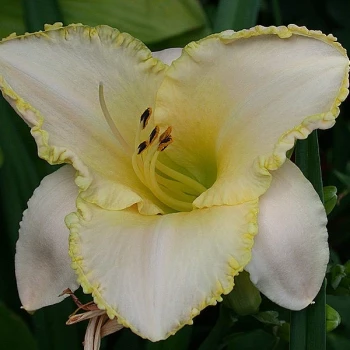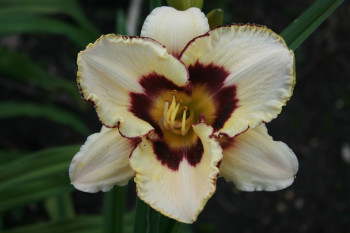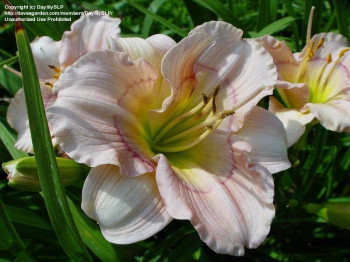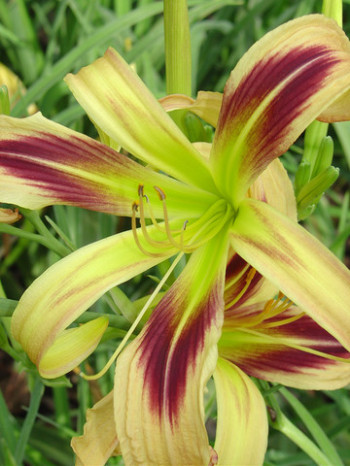The Daylily Explained
With so much terminology used to explain the many plant and bloom characteristics of the Daylily, this guide is designed to help you understand more readily some of the terms used which you may be unfamiliar with. It will help you understand the plant better and hopefully make a more informed decision on which to grow.
The Plant
Like all plants, the Daylily consist of root, leaves, and flowering stems. A common misconception is that Daylilies grow from a bulb. They do not. Although they do belong loosely to the Lily family, they are not a true lily. This has two advantages over a bulbous Lily. They produce a clump which is much less likely to peter out or ‘disappear’ like bulbous lilies can. They are also non-toxic to people and cats, unlike the true bulbous lily, which is known to be poisonous. In fact, the buds and flowers of the Daylily are edible!
The Roots
There are actually two types of roots to each established plant. You will soon notice when planting new Daylilies that established roots are typically fibrous. However, newer roots are fleshy and have the capability of storing water. This is what makes the plant so able to withstand drier conditions, as it can draw on these reserves when needed. These roots are rhizomatous; therefore, the plant can be described as partly a rhizome.
The Crown is the short area between roots and leaves. It is normally much paler and often almost white. It is where the leaves emerge from; therefore, if the plant is cut back below the crown, it may not shoot again. It is important to remember this when cutting plants back. Sometimes the plant may have the ability to utilize dormant buds from the very base of a root, but this isn’t always the case.
The leaves emerge from the crown and form what is known as a ‘fan’. A fan is basically the term for one growing shoot. You can see why it was so named when you study the growing shoot, as it does look rather ‘fan’ like as the leaves begin to splay out, usually in a flattened formation. An established clump will consist of many fans. A new plant will be known as a single fan.
The leaf growth has three divisions described: dormant, semi-evergreen or evergreen.
Varieties which go fully dormant lose all growth over winter and die back to below the ground, ready to emerge again in the Spring. Evergreen varieties maintain most of their foliage over winter. Semi Evergreens will keep some foliage over winter but die back a little. With the semi-evergreen and evergreen varieties, the difference often becomes a little blurred and less noticeable, as it can be affected by the severity or otherwise of the winter. It was originally thought that dormant varieties were hardier, but field tests have shown that the evergreen types actually prefer a chill period in order to flower well.
The Flower Stem
It is usually described as a ‘scape’ in professional terms. These flower stems can be anywhere from 10” high for the smallest varieties to some which reach over 40”, although these latter tall growers are in the minority. The majority of varieties fall between around 20”-26” in height.
The flowers normally appear towards the top of these flower stems. However, a further descriptive term commonly used is that of branching. This means the flower stem itself has side shoots coming off it, on which the buds are produced. This is an advantage because a variety described as having good branching, which may be as few as 2 branches to as many as five or six, will produce a better display than a variety with no or sporadic branches. They also tend to produce more buds.
The buds themselves are produced over a period of weeks and will mature and open gradually. The flowering season depends on the variety; some older varieties only bloom for 2-3 weeks, but newer varieties can open these buds gradually over a period of up to six weeks.
Season
The flowering season is divided into three as follows:
- Early Season: These varieties normally start to flower mid-June and continue through June and into July.
- Mid-Season: This is when the bulk of varieties bloom, and it is generally through July.
- Late Season: May start to flower towards the end of July and into August; some continue even into September. Final Touch is one of the finest of the late-season varieties.
When a variety is described as having ‘re-blooming’ qualities, this means it can produce secondary flower stems after the main flush has finished. This is valuable because it extends the flowering season.
Some smaller flowered varieties may bloom almost perpetually throughout the Summer and into Autumn with only a brief rest between flower flushes.
Flowering scapes may also produce small leafy growths. These are known as ‘proliferations’. During the course of the season, these tiny plants [‘babies brought by the stalk’] will produce small aerial roots. They can, at that point, be removed and potted where they will make a new plant identical to the parent. This method of propagation can be worthwhile to the home gardener, but is seldom used by Nurseries as the plantlets take a long time to mature to flowering age.
Ploidy
It is a technical term that tells you how many chromosomes a variety has. This might not sound of great interest or use to the average gardener, but it does have a profound effect on some basics of the plant's growth.
The original Hemerocallis species were all diploids – 2 chromosomes. Early varieties were all derived from these original Hemerocallis species found growing wild in Asia. Hard to believe. These are known as diploids. But laboratory work and selective breeding brought about varieties with 3 chromosomes. These are known as tetraploids.
These days, most modern new varieties are tetraploids, and they have more robust scapes, greater flower capacity and petals which have a thicker, heavier texture. The leaves of a tetraploid, although still narrow and in keeping with the Daylilies' original characteristics, are ever so slightly wider than a Diploid.
Which is better – diploids or tetraploids?
A debate that has been argued over for decades. Initially, you would be forgiven for thinking that tetraploids, with their greater vigour and more fulsome flower form, definitely have the advantage. But some still love the graceful outline of the older diploids. They also increase more quickly than tetraploids, so you get a clump in no time. Some tetraploids only increase at a rate of one or two fans per season. Tetraploids are often described as having better flower form. Form refers to the outline of the flower, being more fulsome and ruffled. One of the foremost goals of Daylily hybridizers today is for better and better form, and it is hard to deny the extravagant beauty these varieties possess. Older diploid varieties don’t have such a circular form but are more graceful and sometimes still preferred.
I guess it’s like going to a restaurant and being asked if you would like cream or custard with your pudding.
Texture means the heaviness or crispness of the bloom. Modern-day tetraploids have almost impossibly heavy porcelain-like texture and feel, whereas diploids may be a bit more ‘flimsy’, but again, this does add grace to the display.
The Flowers
Described from the very centre to the outer petals consists of:
The throat. This is usually greenish or yellow to gold in colour. From the throat, you get what is known as the ‘eyezone’, which is a narrow band extending out from the throat. Often this is self coloured [ie the petals are all the same colour]. However, selective breeding has resulted in many named varieties which have a very different eye pattern. One of the most famous examples of this is Canadian Border Patrol. An eyezone can be all the same colour, or sometimes a blend of colours within the same spectrum, such as Baby Blues, where the bluish eye is further etched in cerise.
The outer edge of the petals can be simple and tailored, or in newer varieties, they can have what is known as an edge. This is usually used in descriptive terms for the flower when it is extravagantly or noticeably ruffled, and may also have a narrow band of colour which usually matches that of the eye-zone. A good example of an ‘edged’ cultivar is Glacier Bay, which is very ruffled and edged in gold.
Petals and Sepals
At first glance, a single Daylily flower just looks like six petals. However, look closely and you will see that three of them are actually set just slightly behind the other three. These are known as sepals rather than true petals. It can be important to differentiate between the two because a limited number of varieties may have sepals which are a slightly different colour to the true petals. A good example of this is Full Moon Magic.
Flower Forms
The majority are known as ‘single’, which means there is one base layer of petals. But some flowers as double flowers that may have eight, ten or more petals, recall the structure of a rose or camellia. They are increasingly popular with gardeners today.
The ‘spider type’ Daylily is characterised by very long, narrow petals – hence the term spider. These are the darlings of garden designers as they harmonise very well in mixed borders.
So there you have the main terminology used to describe the infinite variety and diversity of today's Daylily. I hope you have found it useful – and interesting too.






